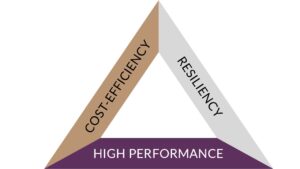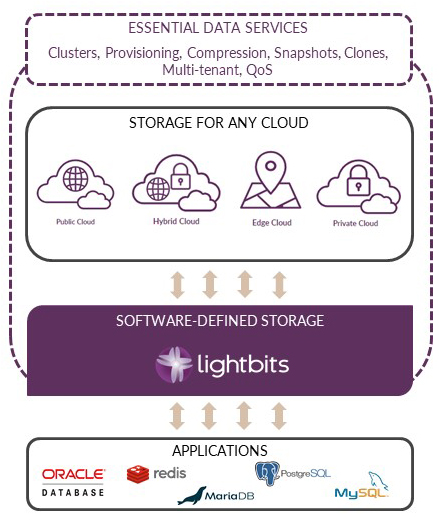This educational blog presents a high-level overview of the benefits of software-defined storage. For more complete and technical information start with our LightGUIDE on Software-Defined Storage.
Software-defined storage (SDS) solutions represent a paradigm shift in data management, offering the ability to transform how you manage your storage infrastructure by delivering improvements in scalability, flexibility, and cost-efficiency. SDS gained significant momentum in the mid-2000s, the origins of which are often credited to virtualization technology from VMware. Decades later, the shift towards cloud-native architectures has further accelerated the adoption of SDS as it continues to transform how organizations manage their storage infrastructure. Below are five key ways in which SDS can solve your storage management challenges, enable the modernization of your data center, and improve IT infrastructure efficiency.

The benefits of implementing the Lightbits high-performance software-defined storage platform
1. Enhanced Scalability and Flexibility
One of the most significant challenges with traditional storage systems is scalability. As data volumes grow, you can’t expand your storage capacity without incurring substantial costs and introducing complexity. Software-defined storage solves this challenge because the storage software is decoupled from the hardware, allowing seamless scalability. Storage nodes can be added for horizontal scaling without disrupting operations. Adding capacity is as simple as integrating new storage devices into the existing pool, which the software manages uniformly.
Most organizations want to avoid vendor lock-in at all costs and traditional storage solutions can often lock you into specific vendors and proprietary hardware. SDS, however, is vendor-agnostic, supporting a wide range of storage hardware from different manufacturers. This flexibility allows you to choose the hardware that best meets your requirements, optimizing their storage environment for performance, cost, and capacity needs. Additionally, SDS can dynamically adjust to changing workloads and data requirements. For instance, during periods of high demand, SDS can allocate more resources to critical applications, ensuring consistent performance. This adaptability is crucial for businesses with fluctuating data needs, such as e-commerce platforms that require the ability to auto-scale services in response to demand.
2. Cost Efficiency
We hear from our customers time and again that managing storage costs is a perennial challenge. SDS offers several ways to mitigate the high CapEx and OpEx costs associated with traditional storage systems. Because SDS is vendor-agnostic you can leverage commodity servers and storage devices, avoiding the premium prices associated with proprietary hardware.
Other features of SDS that can lower costs are automation and optimization of resource utilization. Many of the manual tasks associated with storage management, such as provisioning, monitoring, and maintenance can be automated with SDS reducing the need for specialized IT staff, which significantly lowers OpEx. Additionally, the centralized management capabilities of SDS streamline administrative tasks, further reducing the workload on IT teams. You will also discover that traditional storage systems often suffer from underutilization of resources due to siloed storage environments. SDS consolidates these silos into a single, virtualized pool, ensuring that storage resources are used more efficiently. This optimization reduces the need for over-provisioning and allows you to get more value out of your hardware.
3. Improved Data Protection
Data protection and disaster recovery are critical components of any data center infrastructure strategy. Both are enhanced through advanced SDS features that improve reliability and resilience. Software-defined storage solutions often include built-in essential data services like replication, data deduplication, compression, and encryption, which enhance data protection, integrity, and security. Because data can be replicated across multiple nodes or locations, it ensures that data is always available, even in the event of hardware failure. Encryption ensures that your data is protected from unauthorized access, both at rest and in transit. While deduplication and compression optimize storage space and reduce the risk of data corruption, while also having a positive impact on lowering costs by reducing hardware overhead.
It’s also worth noting that many software-defined storage platforms provide organizations with a comprehensive solution for disaster recovery. Because software licenses can be portable, like Lightbits software-defined storage, you can leverage public cloud resources to replicate and store data off-site. This DR approach minimizes downtime and data loss, enabling quick recovery in the event of a catastrophic failure and ensuring business continuity.
4. Simplified Management and Automation
Traditional storage systems can introduce complexity into your data center, be time-consuming to procure and provision and require specialized skills to manage. SDS simplifies the management of storage infrastructure through automation and centralized management, allowing you to focus less on your storage and more on strategic initiatives. A centralized management interface offers a single point of control to monitor performance, allocate resources, and manage policies for the entire cluster from a unified platform. By implementing policy-based management, you can automate routine tasks like data placement, access controls, and backup schedules, while enforcing compliance. Once set, these policies are automatically applied, ensuring consistent and reliable storage management. Additionally, software-defined storage platforms often integrate with existing orchestration frameworks, such as Kubernetes, VMware, OpenStack, and Openshift. This integration streamlines workflows and enhances the overall efficiency of your operations.
5. Future-Proofing and Innovation
Upgrading traditional storage systems often involves significant downtime and complex migrations. SDS simplifies this process by enabling non-disruptive upgrades. Unlike traditional storage systems that may require costly hardware upgrades for new features, SDS can introduce new capabilities through software updates. New hardware can be added, and old hardware can be decommissioned without affecting the overall system. This capability ensures that you can take advantage of the latest advancements in storage technology without significant investments or interrupting business operations.
Software-Defined Storage Vendors
SDS encompasses a range of technologies with numerous software-defined storage vendors catering to different aspects of enterprise storage needs, from large-scale object storage to integrated Hyper-converged Infrastructure (HCI) platforms, like VMware vSphere. There are also open-source SDS solutions that provide many of the features of commercial software-defined storage solutions but do so without licensing fees. A few examples include SwiftStack and Ceph Storage. There may be considerations around support and complexity, as most rely primarily on community support, which can vary in responsiveness and depth, they may require more technical expertise to deploy and manage, and while robust, free SDS solutions may lack some of the advanced features found in commercial products.
Lightbits Enterprise Cloud Data Platform
The Lightbits enterprise cloud data platform offers an unmatched combination of performance, resiliency, and scalability bringing hyperscale-level efficiency and flexibility to private, on-premises cloud. It’s next-gen block storage, delivering scalable capacity and performance more efficiently than traditional SAN or DAS. With Lightbits in your data center, you can accelerate application performance at scale, and simplify data storage infrastructure management and operations while lowering costs.

Example of Lightbits Data Platform software-defined storage topology
For a more comprehensive overview of software-defined storage vendors, read the LightGUIDE: Software-Defined Storage.
In conclusion, digital transformation can be a challenge and software-defined storage offers a comprehensive solution to the challenges of traditional storage management. The data platform, of which storage is a critical component, plays a key role in enabling today’s modern workloads, like AI/ML, Retrieval Augmented Generation (RAG) models, real-time analytics, eCommerce, and transaction-heavy applications in financial services. SDS provides a future-proof solution designed to support emerging technologies, such as NVMe storage, persistent storage for containers, and storage-class memory. You can adopt new technologies without major disruptions ensuring your storage infrastructure remains current and capable of meeting evolving performance demands.
By enhancing scalability and flexibility, reducing costs, improving data protection, simplifying management, and future-proofing storage infrastructure, SDS empowers you to manage your data more effectively and efficiently. I can assure you, that as your data volumes continue to grow and your cloud-native applications require higher levels of performance and scalability, SDS will play an increasingly critical role in helping you meet your storage needs.
Additional learning materials:

